Continuing our exploration of the enchanting city of Shiraz, we at Parsi Tours Iran Travel Agency, invite you to join us in Part 2 of our journey through this Iranian paradise. In this part, we’ll delve even deeper, unveiling the hidden gems, natural wonders, and the modern delights that await you in this incredible city. So, fasten your seatbelts as we embark on the second part of our adventure and discover the remaining attractions that make Shiraz an unforgettable experience.
Shapuri Mansion
Shapuri Mansion, a masterpiece of architecture in Shiraz, was built during the Pahlavi period between 1310 and 1315. It was crafted by one of Shiraz’s most renowned architects and belonged to Abdulsaheb Shapouri, a prominent local businessman. This splendid mansion is located on Anvari Street, facing Ahli Street. For several years, it was in the possession of the Shapouri family but eventually fell into disuse.
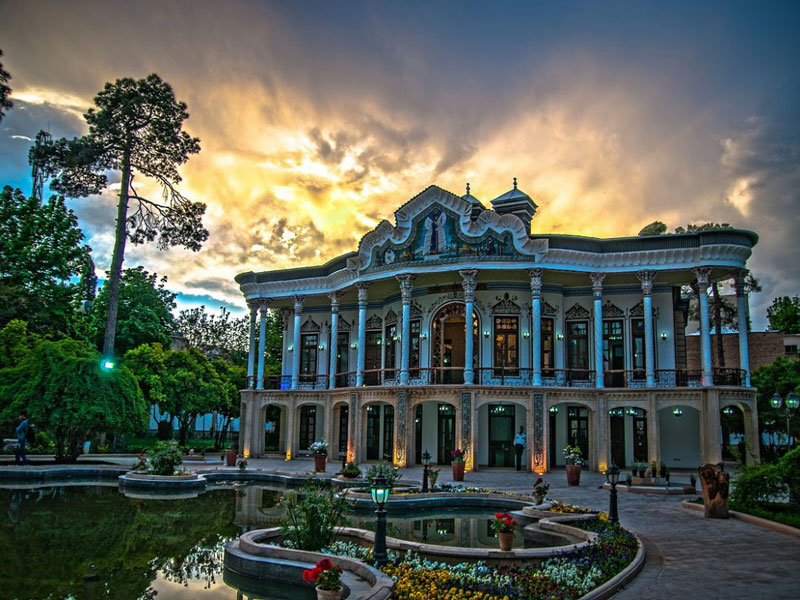
Shapori Mansion
In 1999, the Cultural Heritage Organization of Fars Province acquired the property, and it was officially registered as a national monument of Iran on October 16, 2000, with number 2781. The mansion occupies a plot of land measuring 4,635 square meters, featuring two floors and a base area of 840 square meters. The architectural style reflects the Qajar era, and today, it is open to the public, housing a restaurant, a coffee shop, and exhibitions of cultural and artistic works from Fars Province.
Vakil Bath
Hamam-e Vakil, or Vakil Bath, stands as evidence to the architectural prowess of Karim Khan Zand era and is one of the must-visit places in Shiraz. This historical bathhouse is centrally located, near landmarks such as Vakil Bazaar and Vakil Mosque. Exceptional architectural principles of its time were employed in its construction. The bathhouse includes a king’s room, reserved for the use of the king. The entrance to the bathhouse is designed to maintain heat within the facility, ensuring that cold air remains outside. The bathhouse’s dome features beautiful limestone patterns, inspired by the region’s religious and traditional motifs.
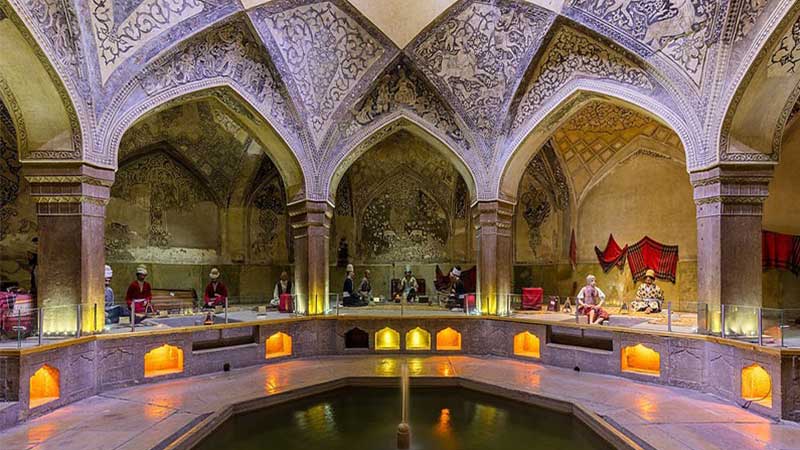
Vakil Bath
Vakil Mosque
Vakil Mosque, an integral part of the Zand buildings complex, is situated near Vakil Bazaar and Vakil Bath. This magnificent mosque boasts a unique architectural and artistic style, highlighted by its southern and eastern Shabestans [part of mosque designed for sleeping or nocturnal paryers]. Karim Khan Zand commissioned the construction of Vakil Mosque, and its notable features include the southern Shabestan with its solid and spiral stone columns. The southern Shabestan spans 5,000 square meters, and the mosque’s 14-step pulpit is crafted from solid marble, believed to have been transported from Maragheh to Shiraz at Karim Khan’s order. This architectural gem was officially recognized as a national monument of Iran, designated as number 182.
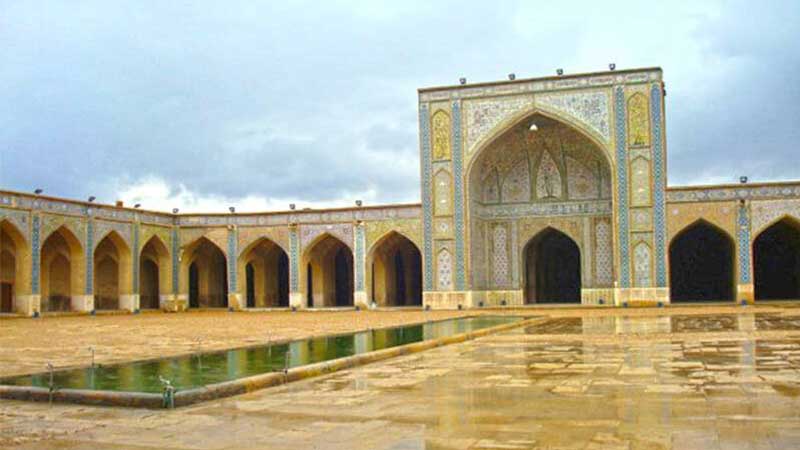
Vakil Mosque
Vakil Bazaar
Vakil Bazaar, one of Iran’s oldest and most renowned traditional markets, was commissioned by Karim Khan Zand himself. It occupies a central location in Shiraz and boasts an exquisite architectural design. The market remains bustling to this day, with various sections bearing names corresponding to the specific industry or goods sold there. Vakil Bazaar is constructed using a combination of plaster, brick, and lime, all resting on foundations of intricately carved stone slabs. This vibrant marketplace has been officially recognized as a national monument of Iran, bearing the number 924.
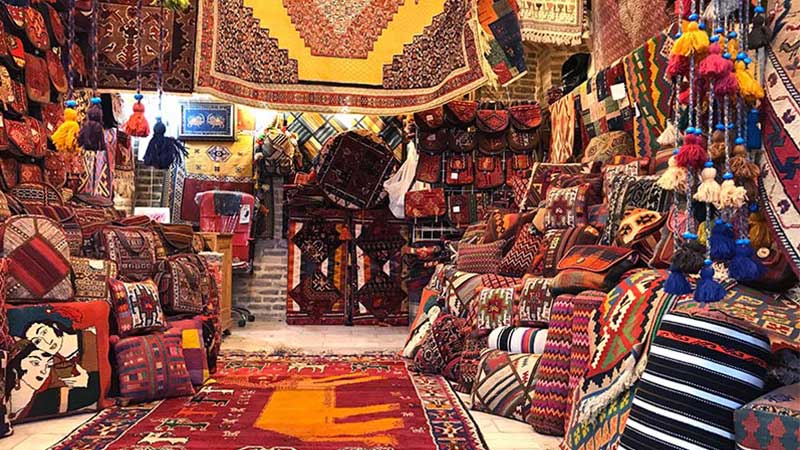
Vakil Bazaar
Kolah farangi Mansion (Vakil’s Tomb)
The Kolah farangi Mansion, also known as Vakil’s Tomb, originates from the Zandian period and stands amid lush greenery in Shiraz. During the Zandian rule, this mansion served as a venue for hosting guests and foreign diplomats, as well as for official ceremonies and festivities. Karim Khan Zand expressed his desire to be buried in the eastern part of the mansion upon his death, earning it the name “Vakil’s Tomb.”
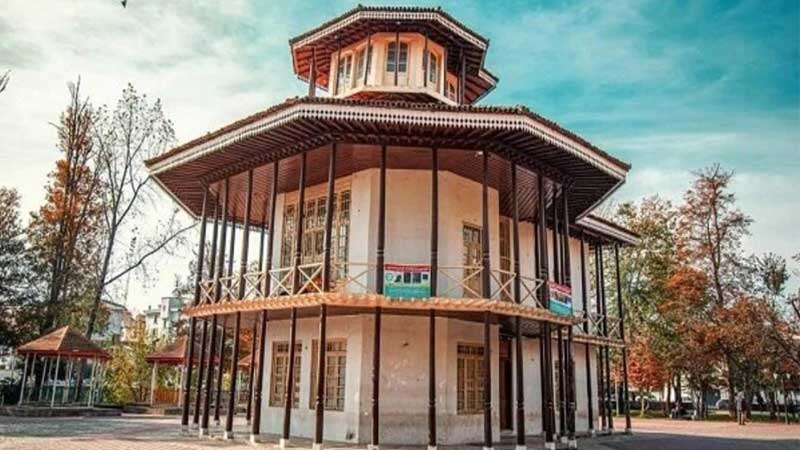
Kolah farangi Mansion in Shiraz
However, in 1206, Agha Mohammad Khan Qajar ordered the removal of his remains, relocating Karim Khan’s bones to Golestan Palace. During the Pahlavi era, Karim Khan’s remains were once again transferred, this time to the garden where the mansion stands today. The octagonal mansion boasts beautiful tilework, featuring intricate designs inspired by religious and traditional motifs. In 1315, the Kolahfarangi Mansion was repurposed as a museum, now housing a collection of historical artifacts from prehistoric and Islamic eras.
House of Zinat Al-Muluk
The House of Zinat Al-Muluk, a historical Qajar-era residence, stands as one of Shiraz’s architectural gems. Its construction was initiated around 1911 by Ali Mohammad Khan Qavam al-Mulk II and completed in 1923. The wooden roof of the house is decorated with paintings depicting animals, birds, flowers, and shrubs. This impressive mansion is situated on Lotf Ali Khan Zand Street, on the western side of Qavam Narenjestan Garden, connected to it by an underground passageway. The house derives its name from Zainat al-Muluk Qavami, the daughter of Qavam al-Mulk IV, who resided there. The building also features a grand hall decorated with exquisite mirrors and plasterwork. Its spacious basement now serves as a gallery showcasing statues of notable figures from Fars Province, open to the public. The House of Zainat Al-Muluk was officially recognized as a national monument of Iran on December 10, 1972, bearing the number 938.
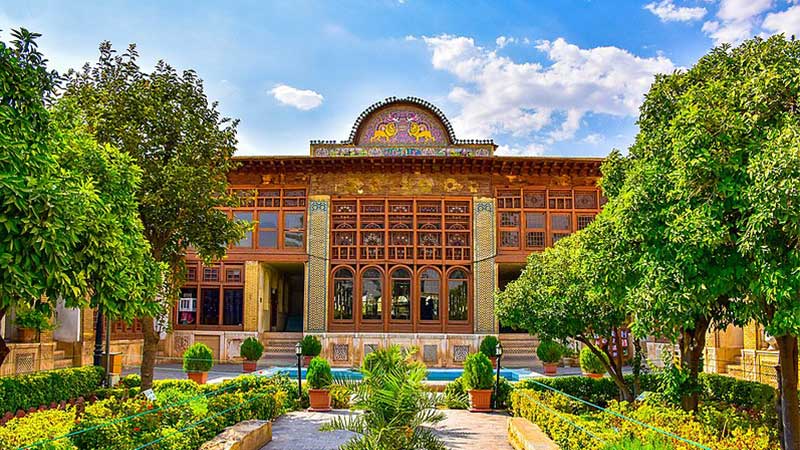
House of Zinat Al-Muluk
Nasir al-Mulk Mosque
The Nasir al-Mulk Mosque, also known as the Pink Mosque, was constructed by order of Mirza Hasan Ali Khan, an esteemed noble of Shiraz who bore the title Nasir al-Mulk. The mosque’s construction spanned approximately 12 years, from 1876 to 1888. The mosque boasts a grand courtyard in its northern section, featuring a prominent arched entrance adorned with colorful tiles. The mosque has two entrances and two shabestans, on each of the eastern and western sides. It also has two northern and southern courtyards. Notably, the northern courtyard stands out with its exceptional beauty compared to the southern one. Efforts are currently underway to restore this architectural masterpiece to international standards. The Nasir al-Mulk Mosque is located to the south of Lotf Ali Khan Zand Street, in proximity to Shahcheragh and Nasirul Molk Alley.
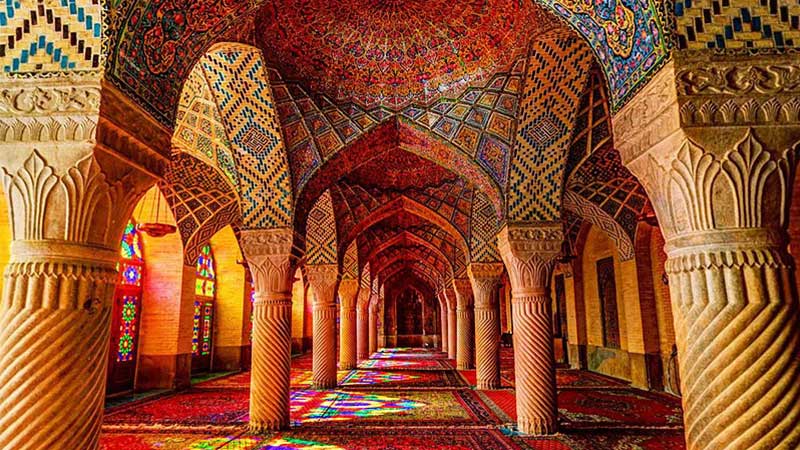
Nasir al-Mulk Mosque in Shiraz
Old Grand Mosque (Jame Atiq Mosque)
The Jame Atiq Mosque of Shiraz, also known as the Old Grand Mosque, holds the distinction of being the city’s oldest mosque. It is alternatively referred to as the Jome (Friday) Mosque or Adina Mosque. The origins of this mosque trace back to a place of worship, though the exact era of its inception remains uncertain. The initial mosque structure was erected in 281 AH during the reign of Amruleith Safari. In 752 AH, Shah Ishaq constructed the “Dar al-Musahef” within the mosque, intended for the storage and recitation of the Holy Quran. The mosque bears an inscription by Yahi al-Jamali al-Sufi, a renowned calligrapher of Shah Ishaq’s era, extolling the virtues of the Holy Quran. The mosque boasts six entrances and was officially recognized as a national monument of Iran on January 15, 1310, with number 72.
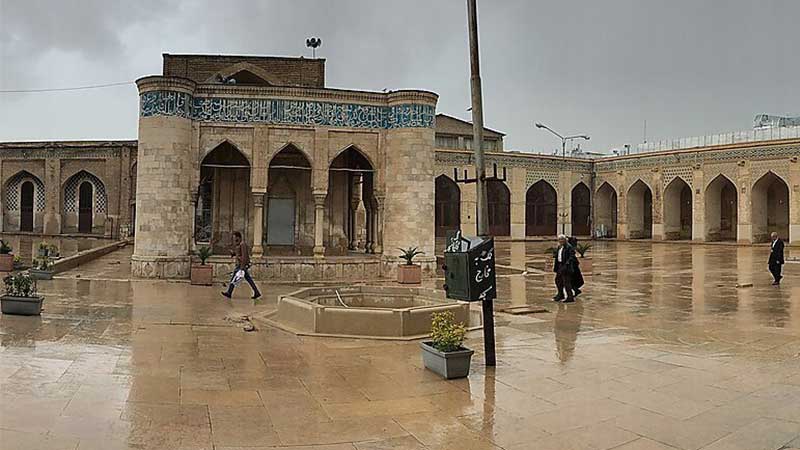
Old Grand Mosque (Jame Atiq Mosque)
Shiraz Music Museum
The Music Museum, also known as the Manteghi Nejad House, is located within a historical Qajar-era building. This building contains rooms in its eastern and western sections, as well as a palace. The Shahneshin Museum building was nationally registered in 1352. The museum features exhibits on international music, Iranian musical instruments, a music studio, and an archive room, among other sections.
Persepolis
Persepolis is one of the most famous and highly sought-after historical complexes in Fars Province. Situated approximately 55 kilometers from Shiraz, it is a prime destination for tourists visiting the city. This historical marvel encompasses Achaemenid palaces and is commonly referred to as the Arg-e Parse. It is renowned as Iran’s largest stone construction, spanning over 125,000 square meters. Persepolis is perched atop a rocky outcrop on the east side of Mahd Mountain (Rahmat Mountain), surrounded by the Marvdasht Valley to the north, south, and west. The length of Persepolis matches that of the Acropolis in Athens, while its width is four to five times greater. Darius the Great initiated the construction of Persepolis about 2,500 years ago, with subsequent modifications and additions by his successors. Marvdasht lies approximately 40 kilometers north of Shiraz on the road to Isfahan, and it is roughly 880 kilometers from Tehran.
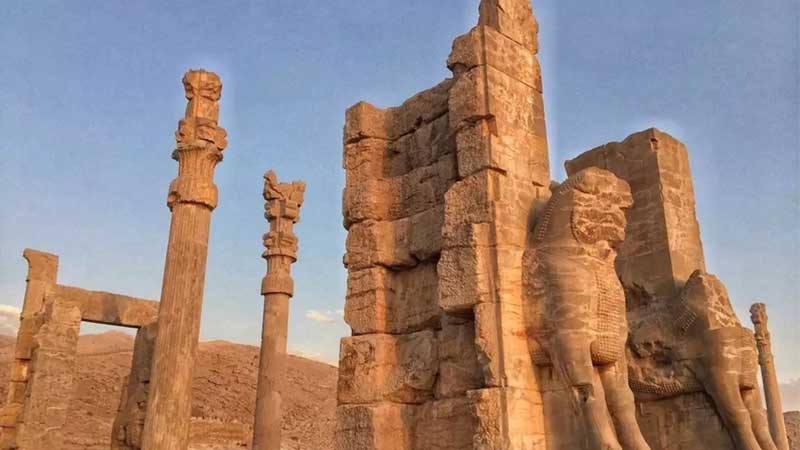
Persepolis
Pasargadae: Tomb of Cyrus the Great
The Pasargadae complex ranks among Iran’s most captivating historical attractions. Located approximately 30 kilometers from Shiraz, Pasargadae represents a collection of ancient structures from the Achaemenid era, situated in Fars Province. This comprehensive complex includes notable features such as the Tomb of Cyrus the Great, Pasargadae Royal Garden, Gate Palace, Bridge, Bar-am Palace, Exclusive Palace, two koshks, Shahi Garden water features, Kambojie Tomb, Tel Takht defensive structures, Mozafari Caravanserai, Sacred Area, and Bolaghi Gorge. Pasargadae continues to attract visitors with its rich historical heritage.
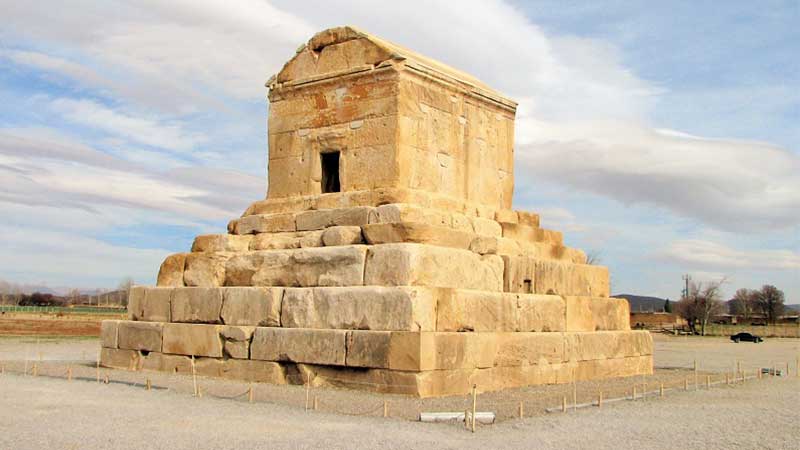
Pasargadae: Tomb of Cyrus the Great
Conclusion
These are some of the must-see places in Shiraz and its surroundings, each offering a unique glimpse into the rich history and culture of the region. Whether you are interested in ancient history, stunning gardens, or architectural wonders, Shiraz has something to offer to every traveler. Enjoy your visit to this enchanting city!



